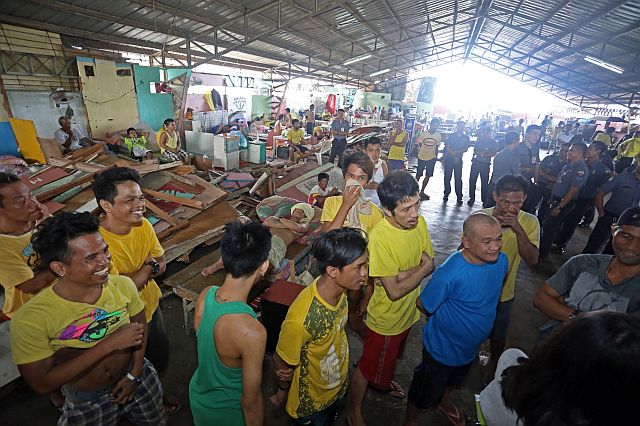
With a new warden taking over the Cebu City Jail,the kubols (huts) that granted private “rooms” to some favored inmates also disappeared, providing more space to the heavily congested jail. (CDN PHOTO/LITO TECSON)
If Willy Paca has a choice, he wants to be with his family.
But the 43-year-old resident of Barangay Pasil in Cebu City ended up in jail after he was accused of stealing a motorcycle.
He has been behind bars for three years now.
“Lisud kaayo ang among kahimtang diri. Huot kaayo mi. Nagnihit pa ang tubig. (We’re suffering inside the jail. It’s very congested and water is scarce),” Paca told Cebu Daily News.
Over the past year, Paca said his case has been scheduled for hearing in court only at least twice, making him stay longer inside the Cebu City Jail.
In some occasions, court proceedings were cancelled and postponed to another date due to the absence of either the judge, the prosecutor or the lawyers.
“Hinay gyud kaayo ang dagan sa mga kaso. (Cases move so slowly),” Paca lamented.
Fivefold
Supt. Jessie Calumpang, the new warden of the Cebu City Jail, said congestion is the primary problem that has been confronting all the jails in the country for decades.
The Cebu City Jail, for example, is supposed to only house 600 inmates but now has five times its ideal population, with 3,102 detainees currently held at the jail.
Calumpang said the slow disposal of cases due to the lack of trial courts, coupled with scarcity of funds to construct bigger detention facilities, have been considered the primary reasons behind the severe prison overcrowding.
“We didn’t expect to have this number of inmates,” he said.
Calumpang appealed to the government to allocate budgets for the creation of new jails and trial courts.
He said the overcrowded detention facilities in Cebu City, as well as in other parts of the country, have generated different types of illnesses and diseases among inmates.
Ailments
At the Cebu City Jail, about 100 prisoners were diagnosed with tuberculosis (TB), an infectious bacterial disease that affects the lungs.
Tuberculosis is transmitted from person to person through droplets from the throat and lungs of people diagnosed with the active respiratory disease.
While inmates with tuberculosis were separated from the others, Calumpang said it was possible that they could still infect other prisoners and even visitors.
“For some mayors and other government officials, jails are their last priority. Hopefully, they will help us,” he said.
Aside from respiratory illnesses, inmates also suffer from hypertension, headaches, arthritis, diarrhea, asthma, migraine, fever, and scabies — a skin condition that causes severe itching due to tiny mites.
Squatting position
In 2015, records of the Bureau of Jail Management and Penology (BJMP) showed that jail congestion in all 34 detention facilities in Cebu and in Central Visayas has reached a “staggering” 378 percent.
The jails are filled to to the brim that some inmates just squat on the floor while they lean their heads on steel bars for them to sleep at night.
The congestion, however, continued even when in December 2014, the Supreme Court, in an effort to reduce backlogs, introduced a program called “Judgement Day” when the trial courts handed over verdicts simultaneously.
The High Court also launched the “Hustisyeah” program in Cebu to unclog court dockets and address jail congestion.
A total of 20 courts in Cebu with more than 38,000 cases were assisted by a team composed of lawyers and students in an attempt to reduced the case loads.
Dignity
Calumpang said he’s hoping that inmates will be given dignity despite the accusations levelled against them.
“We have this notion that prisoners should be made to suffer because they committed wrongdoings, but we should also give them dignity and provide them a humane facility, so to speak,” he said.